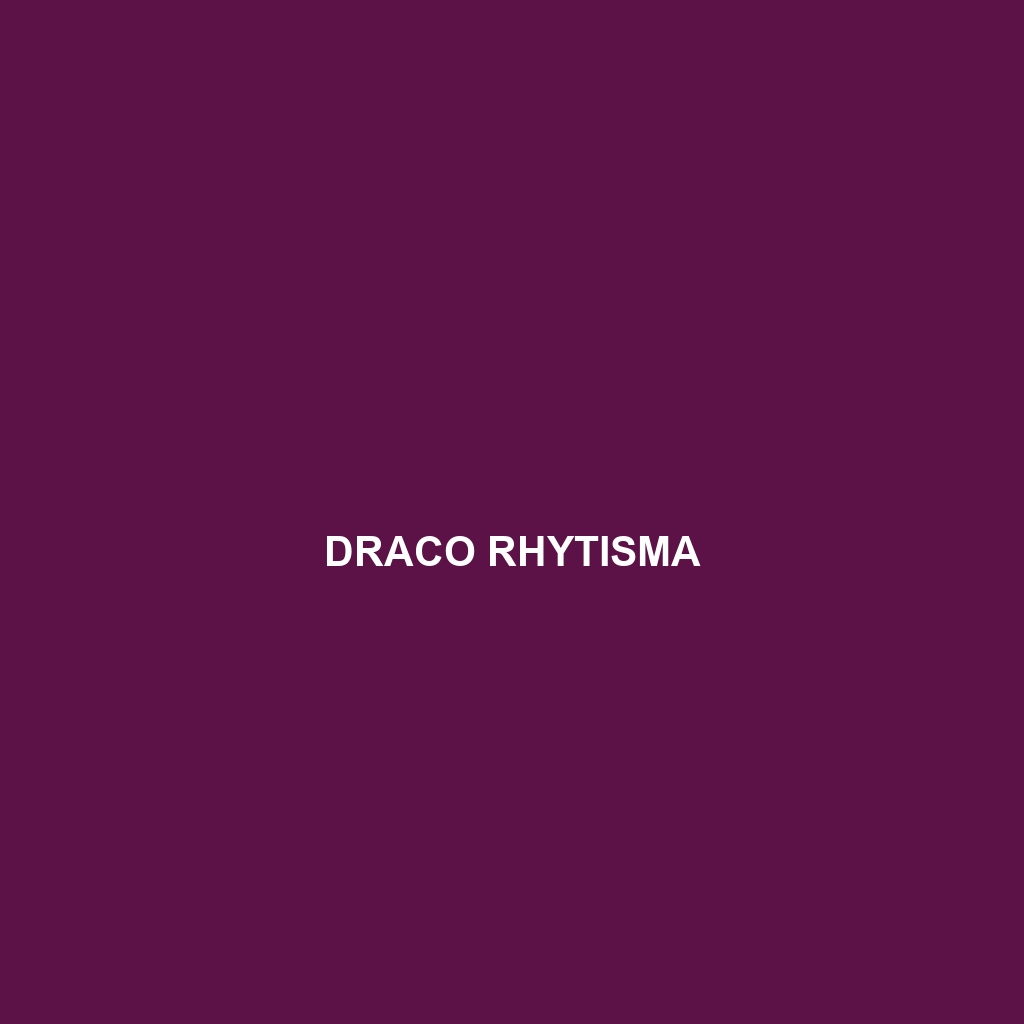Common Name
Draco rhytisma
Scientific Name
Draco rhytisma
Habitat
Draco rhytisma is primarily found in tropical regions, specifically within lush, dense rainforests and certain temperate forests across Southeast Asia. This species thrives in humid, warm climates, often inhabiting areas near freshwater sources like rivers and streams that provide necessary hydration and sustenance. The adaptability of Draco rhytisma allows it to exploit various ecological niches, including canopy layers of rainforests, where it can find abundant food and avoid predators. The combination of high humidity and temperature coupled with ample vegetation creates an ideal environment for its survival and reproduction, making these ecosystems vital to its population.
Physical Characteristics
Draco rhytisma is notable for its unique morphology. Generally, this species can reach up to 60 centimeters (about 24 inches) in length, with a streamlined body adapted for gliding. Its coloration typically features a rich blend of greens and browns, allowing it to camouflage seamlessly among the foliage, a tactic essential for evading predators. A distinctive feature is the wing-like flaps of skin that extend from the ribcage, which it uses to glide through the forest canopy. This anatomical adaptation not only aids mobility but also enhances its ability to traverse large distances in search of food. Additionally, the species displays a vibrant throat flap which can expand dramatically during mating displays, making it an intriguing subject for both researchers and enthusiasts alike.
Behavior
Typically, Draco rhytisma exhibits diurnal behavior, being most active during the day. It is known for its gliding prowess, which allows it to traverse between trees in search of food or potential mates. Mates perform a fascinating courtship ritual that includes elaborate displays of their throat flap, showcasing physical dominance and health. Social interactions among individuals can be complex, often involving territorial disputes or cooperative feeding behaviors, especially during times of food scarcity. These engaging traits make Draco rhytisma a compelling species for observation and study.
Diet
Draco rhytisma is primarily an insectivore, feeding mainly on a diet rich in ants, termites, and other small insects found on the surfaces of tree trunks and leaves. It utilizes its specialized tongue to capture prey, demonstrating remarkable agility and precision. Interestingly, while predominantly insectivorous, instances of Draco rhytisma consuming fruits have been documented, leading some researchers to consider it as an opportunistic feeder. This dietary flexibility allows it to adapt to the seasonal variations in food availability within its rainforest habitat.
Reproduction
The reproductive cycle of Draco rhytisma typically begins in the late rainy season, when mating occurs. Females generally lay a clutch of 2-3 eggs, which they incubate for about 45 days before hatching. Notably, parental care is limited, with hatchlings becoming independent shortly after they emerge. The young are born with the same physical adaptations as adults, allowing them to immediately fend for themselves in the treetops. Successful reproduction is crucial for maintaining the population of Draco rhytisma, especially considering the pressures their habitats face from deforestation and climate change.
Conservation Status
The conservation status of Draco rhytisma is currently classified as ‘Vulnerable’ according to the International Union for Conservation of Nature (IUCN). This designation is largely due to habitat loss from logging, agricultural expansion, and urban development. Conservation efforts focus on habitat preservation and the establishment of protected areas to ensure the continued survival of this fascinating species. Ongoing research and awareness initiatives are crucial for assessing population dynamics and fostering sustainable practices among local communities.
Interesting Facts
One of the most astonishing aspects of Draco rhytisma is its ability to glide through the air, sometimes covering distances of over 10 meters (about 30 feet) without flapping its limbs. This remarkable adaptation not only aids in mobility but also enhances its escapability from predators. Additionally, Draco rhytisma has been observed engaging in communal roosting behaviors, where individuals gather in small groups, providing safety in numbers and social interaction.
Role in Ecosystem
Draco rhytisma plays a significant ecological role within its habitat, acting as both a predator and, to some extent, a pollinator. By feeding on insects, it helps regulate insect populations, contributing to the overall balance of the ecosystem. Furthermore, when it consumes fruits and disperses seeds, it aids in plant propagation and forest regeneration. Such interactions highlight the importance of Draco rhytisma as a keystone species, essential for maintaining the health and diversity of its rainforest environment.
